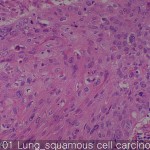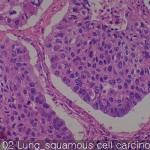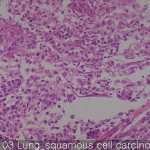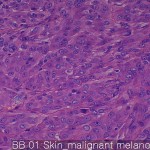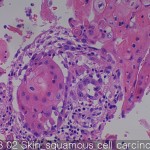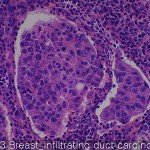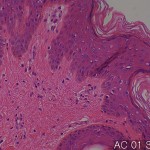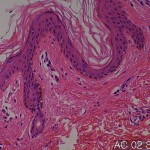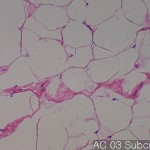Full list with analysis of all the Human Tissue Array products that Gentaur provides.
Tag Archives: products
Polyclonal Antibodies
Gentaur institute offers a service that is the production of polyclonal antibodies. The client provides the immunogen and Gentaur does the rest.
GentoDenz
Gentodenz is non-ionc, non-toxic and is very water soluble. Solutions up to 80 % (w/v) can be prepared. Aqueous solutions have a very high water activity. Most particles will are fully hydrated in solutions of Gentodenz and will band at a low density.
Colon and rectum cancer
| Product name | Colon and rectum cancer |
| Cat. No. | CD |
| Current version | CD4 |
| Data sheet | CD4.pdf |
| No. of samples | 59 |
| No. of patients | 59 |
| Core diameter | 2.0 mm |
| Section thickness | 4 micrometer |
| Price | 244 EUR |
| 320 USD | |
| 210 GBP |
Product Related Literature
In addition, in colon cancer known as cancer or colon cancer of the colon, cancer, are in addition to uncontrolled growth of cells in the colon or rectum or is (colon). The genetic analysis of colorectal tumor essentially, the same genetically, indicating that it is a cancer. Typically, symptoms of colorectal cancer, would include rectal bleeding that is associated with changes in bowel habits and weight loss, sometimes anemia.
As a fraction of the cases hereditary disease underlying are involved, colon most cancers can be attributed to age and lifestyle. Usually begins in the intestinal mucosa, and if not treated, the lower, which in turn can be converted into the muscular layer through the intestinal wall. Screening and is effective in reducing the risk of death from colon cancer, it is recommended starting at age 50, people will continue until 75 years old. Usually, colon cancer, which is localized be diagnosed by colonoscopy or S-shaped colonoscopy.
Cancer in the wall of the intestine, while the cancer has spread widely in the body, curing is not cured typically often surgically, control, attention to the durability of the human using chemotherapy then , I have improved the quality of life. Colorectal cancer is a cancer that is most frequently diagnosed in the three largest in the world, but the developed countries is common it. About 60% of cases are diagnosed in developed countries. It is estimated that that all over the world in 2008, new cases of 1.23 million of colon cancer will be diagnosed clinically, it killed 608 million people.
Symptoms and signs of colon cancer is dependent on the position of the colon tumor whether it has spread to other parts of the body (the transition). Traditional signs include: worsening of constipation, blood in feces, reduction of gauge stool, loss of appetite, weight loss, and anyone over the age of 50 nausea and vomiting. Anemia and rectal bleeding is a function of high risk in patients over 50 years of age, but symptoms including weight loss and a change in bowel habits, it was generally described other is related only usually if bleeding.
Genetic risk will occur with little or no greater than 95 percent from 75 of colon cancer in humans. About 10 percent of cases are older age, male sex, high-fat, red meat and alcohol, obesity, smoking, and lack of exercise is associated with insufficient activity other risk factors. I see more than one drink will increase day by day the risk of alcohol.
People with (ulcerative colitis and Crohn’s disease) and inflammatory bowel disease, the risk of colon cancer is high. Long human risk is greater than had worsening severity of inflammation and disease. It is recommended for prevention and high-risk group of these in colonoscopy and regular aspirin. People with inflammatory bowel disease, accounting for less than 2% of colon cancer cases every year. 2% is a colorectal cancer 8% in ’10 after 20 years in those with Crohn’s disease, 18% after 30 years. About 16 percent of developing colon cancer or precursor cancer and after 30 years in those with ulcerative colitis.
Those having a family history of primary more than two, the risk of increased two to three times the disease, which will be explained about 20% of the group of all cases. Number of genetic syndrome is associated with rate of colon cancer in high. Familial adenomatous polyposis and Gardner’s syndrome in the (FAP), most commonly, hereditary nonpolyposis it is present in about 3% of persons with colorectal cancer.Other syndrome strongly associated in these It almost always happens, the cancer is (Lynch syndrome or HNPCC) colon cancer, cause 1% of cases.
Most of the deaths from colorectal cancer that is associated with metastatic disease. Transition associated with cancer Colon, one – the gene that appears to contribute to the likelihood of metastatic disease, I was isolated. This is a transcription factor that affects the expression of hepatocyte growth factor. This gene is linked to a distributed invasion of colon cancer in metastasis and tumor growth in mice and cell cultures, and distribution. It is also associated with response to treatment.
Change of genetic variation of colon cancer general are also much more epigenetic changes. And others Vogel is as described, (together referred to as “driver mutations”) in, 1-5 tumor suppressor mutation with a mutation “passenger” and about 60 extra carcinogenic mutations in one or two only average colon cancer some. It has been well-studied tumor suppressor genes and oncogenes, will be described in the pathogenesis.
Lung cancer-metastasis-normal
| Product name | Lung cancer-metastasis-normal |
| Cat. No. | CCA |
| Current version | CCA4 |
| Data sheet | CCA4.pdf |
| No. of samples | 59 |
| No. of patients | 40 |
| Core diameter | 2.0 mm |
| Section thickness | 4 micrometer |
| Price | 244 EUR |
| 320 USD | |
| 210 GBP |
Product Related Literature
It is similar to many other types of lung metastatic cancer, lung cancer is initiated by activation of inactivation of tumor suppressor genes or oncogenes. It is believed that people cancer gene, cancer and the more susceptible. I have considered proto-oncogene and become cancerous gene when exposed to carcinogenic substances. Mutations in proto-oncogene of K-RAS is responsible for 10-30% of lung adenocarcinoma. Epidermal growth factor (EGFR), which regulates cell proliferation, apoptosis, and tumor invasion and angiogenesis. Amplification and mutation of the EGFR is common in non-small cell lung cancer, and provide the basis for treatment with EGFR inhibitors. The HER2/neu is affected too much. Chromosome damage, can lead to loss of heterozygosity. This can lead to inactivation of tumor suppressor genes. Staining 3P, 5q is particularly common in small cell lung cancer is damage to the 17p and, of 13q. P53 tumor suppressor gene in the chromosome 17P on, is affected by the 75 percent of cases from 60. Is amplified or mutated frequently, c-MET, NKX2-1, LKB1, PIK3CA, and other genes, is BRAF.
When you do a chest X-ray examination, it is the first step to investigate if the symptoms a person suggest the lung cancer has been reported. This can be (suggesting spread to lymph nodes there) mediastinum, to clarify the expansion of pleural effusion atelectasis (collapse), or integrated (pneumonia), an obvious mass. Typically, CT imaging can be used to provide more information about the type and extent of disease. CT-guided biopsy or bronchoscopy is used to take a sample of the tumor for histopathological examination often.
In many cases, lung cancer can appear as solitary pulmonary nodule of the chest X-ray photo. However, differential diagnosis is wide. You can include organizing pneumonia tuberculosis, fungal infection, or metastatic cancer, to give something like this also, disease and many others. Common cause less solitary pulmonary nodule include hamartoma, bronchial cyst, adenoma, arteriovenous malformation, pulmonary sequestration, rheumatoid nodule, the lymphoma and Wegener’s granulomatosis. Lung cancer can be as lung nodules single CT scan or on X-ray that was done for reasons unrelated breast, to discover at random. Definitive diagnosis of lung cancer is based on histological examination of suspicious tissue in the context of the radiological features and clinical.
It is classified according to the lung histological type. This classification is important in determining the prognosis and management of the disease outcome. The majority of lung cancer is a cancer arising from epithelial cells. Lung cancer is classified by the type and size of the observed cancer cells under a microscope from histopathologist. Two classes are small cell lung cancer and small cell.
Adenocarcinoma, squamous cell lung cancer, a major three subtypes of NSCLC is a large cell lung cancer. About 40% of lung cancer, are originating from peripheral lung tissue usually. Most cases of adenocarcinoma associated with smoking, among those who smoked less than 100 in the life of (“smokers never”), adenocarcinoma is the most common form of lung cancer. Subtypes of bronchioloalveolar adenocarcinoma, the woman who does not have a never smoker is common, there may be long-term survival excellent. Squamous cell carcinoma, accounting for about 30% of the lung. They usually occur in the vicinity of large airway. The cavity associated with cell death, often, I can be found in the center of the tumor. About 9% of the lung is large cell carcinoma. Cancer cells is large, in the black of visible nucleolus great quality and very, are named them.
When you stage a lung cancer, it is the evaluation of the degree of spread of cancer from its original source. This is one of the factors that can affect the potential treatment of lung cancer and prediction. Initial evaluation non-small cell lung cancer using the TNM staging classification (NSCLC). The size of the primary tumor, lymph nodes and this is based on the involvement of distant metastases. Then, using the TNM descriptor 0 through stage one group begins cancers feces are determined and IV IA (A-), IB, IIA, IIB, IIIA, and IIIB.
In this step, I will assist the band selection of the evaluation of prognosis and treatment. Are classified small cell lung cancer “period”, the (SCLC) traditional (not limited to half of the breast, allowable radiation field) “rich stage” or as (widespread disease). However, grouping and TNM classification are useful for evaluating the prognosis. Case of SCLC and NSCLC, clinical stage, the main types of braking score 2, has been staging surgery. Clinical stage is carried out before the final operation. The image inspection (for example, PET scan and CT scan), are based on the results of the biopsy. Is evaluated after surgery or during surgical staging is based on the combined results of clinical data and includes a surgical sample of thoracic lymph nodes.
Normal organs and cancers
| Product name | Normal organs and cancers |
| Cat. No. | BC |
| Current version | BC8 |
| Data sheet | BC8.pdf |
| No. of samples | 59 |
| No. of patients | 59 |
| Core diameter | 2.0 mm |
| Section thickness | 4 micrometer |
| Description | No. of normal cores : 30 cores No. of cancer cores : 29 cores |
| Price | 244 EUR |
| 320 USD | |
| 210 GBP |
Product Related Literature
Person who receives the organs at risk of propagation of cancer is very small, but there are several reports in the medical literature that happen. This is due to the recipient of the organ partially are given drugs to suppress the immune system to prevent transplant rejection. This can not be able to identify the cancer cells that may have been transplanted organ immune system of their kill.
According to the survey of UNOS, there may be a risk that is acceptable to the use of organs from a donor who had certain cancers in certain situations. Long cancer-free interval before the case of organ donation, this is especially true. Currently, we do not recommend the acceptance of organ UNOS, from the spread ‘of active cancer. The exception is the organ donor with primary tumors of the brain not spread outside the brain stem. “This heading is that Zu brain tumors and affect the service life as compared with patients who received donor organs has not been. A study of the recipient of the 500 organ almost any, does not have the disease from donated human tissue that had a brain tumor. acceptance of donated organs to organ and the recipient’s organ procurement agencies .
People with cancer, can be used for living donor due to medical condition, it is possible to be used after several paths still have a tissue or organ of the body. If you want to donate, it is OK to be listed as a donor to the driver’s license of your. Please make sure that too, your family, know your wishes as you may be asked that they give consent. If you have spread inside the cancer, taken internal organs. However, if a long time cancer free die with, you will not be able to use their bodies. It is also possible to use tissues such as often other skin, tendon, and bone and. Careful testing of organs and tissues can occur at the time of death. Decisions about what you can while agree that you wish to donate, the organs and tissues, to be used after this is done by the medical profession his family.
However, tissue and other organs can be is one way to offer help to others, to be used for donation to the cornea of the eye. Individuals almost all of cancer (except those of certain types of eye and blood cancer) is, you can donate the cornea. You can learn more about the donation of the Eye Bank Association of America cornea. If you have any questions about whether there is a case to be able to donate organs and tissues of yourself, you organ procurement center in your area donate life America or UNOS (hereinafter referred to “more”) or, Please contact.
Cancer has the potential to affect any organ of the body. Spread the disease by it, cells of malignant tumors, have the ability to invade tissues and organs surrounding. Similarly, the cancer cells are released from the tumor, enter the blood flow is possible, spread of the disease to other organs. This process is called metastasis propagation. Cancer metastasized, if you have affected other body, disease refers to the body of still occur. If cervical cancer spreads to the lungs, it is called non-lung cancer, and cervical cancer still
Various cancers
| Product name | Various cancers |
| Cat. No. | BB |
| Current version | BB6 |
| Data sheet | BB6.pdf |
| No. of samples | 60 |
| No. of patients | 60 |
| Core diameter | 2.0 mm |
| Section thickness | 4 micrometer |
| Price | 244 EUR |
| 320 USD | |
| 210 GBP |
Product Related Literature
In order to determine the cause and to develop strategies for the treatment prevention, diagnosis, and treatment, cancer research is the basic research of cancer.
Range of Cancer Research, Molecular Biotechnology to conduct clinical trials to evaluate the application of cancer treatment various comparing epidemiological. These applications, treatment will include a combination of surgery, radiation therapy, chemotherapy, hormonal therapy, and immunotherapy, and radiation therapy and chemotherapy. Since the mid-1990s, the emphasis in clinical cancer research, shift towards the treatment, that is derived from the study of biotechnology, such as gene therapy and immunotherapy such.
This type of research includes (chemical carcinogen that is) such as genetics, diet, environmental factors, and a variety of fields. The the causes, with respect to a potential therapeutic target, enters the basic research beginning with data obtained from clinical observations, results were subsequently confirmed independently with convincing obtained route, more human In order to test the safety and efficacy of continuing therapeutic intervention method for clinical research, including research that has been designed properly, people. It is an important part of basic research is a characteristic function of the potential mechanism of carcinogenesis regarding types of epigenetic changes and genetic associated with the development of cancer. Mice often used as a mammalian model for the operation of the function of genes that play a role in tumorigenesis, the main aspects of tumor initiation by mutagenesis were analyzed from cultures of mammalian cells and bacteria.
There are cells of several different types is important for tumor growth. Specifically, endothelial precursor cells, is an important cell populations of tumor growth vessel. Was demonstrated in the journal and development and gene (2008) and (2007) Science impact resistance factor showed that also this finding is important for angiogenesis endothelial progenitor cells and metastasis. This importance of endothelial progenitor cells in angiogenesis and tumor growth, was confirmed by (August 2010) recent publication of cancer research. In this paper ingenious, endothelial progenitor cells, it can be labeled with an inhibitor of DNA binding 1 (ID1) was shown. This new discovery is that it also was able to monitor the endothelial progenitor cells from bone marrow into the blood of tumor stroma, researchers, it was incorporated into the tumor vasculature. This finding of endothelial progenitor cells involved in tumor vasculature, vascular development demonstrates the importance of this cell type in the configuration of the tumor. In addition, removal of endothelial progenitor cells in the bone marrow produces a significant decrease in vascular development and tumor growth. Thus, endothelial progenitor cells, is very important in a new therapeutic target of current and tumor biology.
The purpose of oncogenomics is that of identifying a tumor suppressor gene or oncogene novel capable new insights in the diagnosis of cancer for predicting the outcome of cancer, as well as providing new targets for the treatment of cancer. “The main purpose of the study cancer. Thing to identify the mutated genes that are involved in the causal carcinogenic (cancer gene)”, as described in the 2004 review article cancer genome project, cancer genome It includes being able to investigate the changes in the genome efforts won the genetic mutation from hundreds of thousands of human cancer atlas project sample is related to cancer and cancer of the document space database.
Including different types of about 350 of the tumor, the large projects of these have been identified 3000-130000 mutations in genes that are mutated in tumor. Bulk 286 was observed 33 ares oncogenes and tumor suppressor genes, genes in 319 of them.
I can genetic Several factors increase the risk of cancerous mutations comprising the activation of the inhibition of tumor suppressor genes or oncogenes. Oncology and various features of the tumor suppressor gene can be blocked at various stages of tumor development. Mutations in these genes can be used to classify the malignant tumor. In a later stage, the tumor may express resistance to the treatment of cancer. The determination of tumor suppressor genes and oncogenes, is it, to understand that the success of the treatment and progression of the tumor is important. The role of a given gene in cancer progression, depending on the type and stage of the cancer involved, it may be quite different.
Most funds for cancer research has come from charity non-profit business, and the taxpayer. In the United States, more than 30% of cancer research of all, was funded by the commercial research by pharmaceutical companies. Public spending per capita of cancer research charity and by American taxpayers, is 7 times more public spending by charities and taxpayers in the European Union (EU). As a percentage of GDP, fund cancer research non-profit in the United States, is the amount of four times devoted to cancer research in Europe. Funded by the charity half of the non-cancer research in Europe.
Normal organs from non-cancer patients
| Product name | Normal organs from non-cancer patients |
| Cat. No. | AC |
| Current version | AC1 |
| Data sheet | AC1.pdf |
| No. of samples | 60 |
| No. of patients | 60 |
| Core diameter | 2.0 mm |
| Section thickness | 4 micrometer |
| Price | 244 EUR |
| 320 USD | |
| 210 GBP |
Product Related Literature
After the non-cancer patients, carried out after the war between the development of the movement of the Marie Curie has been suggested, however, good faith, the treatment of terminal care home patients, often totally inadequate due to lack of training and skills is. At this point, he has the experience, Nursing, which has been driven to improve the care of terminal cancer patients who had trained as a doctor with the specific goal to address this issue Sicily and medical caseworker or nurse Saunders (Dame Cicely current). Patient care, dedicated to research and education, she has opened a St. Christopher hospice within 10 years of qualification. It is one of the greatest achievements in the medical half a century last British definitely hospice movement is spreading rapidly. It relies heavily on charity and is not funded by the government yet, but movement was the Dame Cicely message to the attention of doctors around the world.
That the hospice movement should focus primarily on cancer patients it is of course, Notre Dame, Sicily, in certain diseases, was not his intention to limit this approach is it I have said in the introduction of palliative care of Patients1 for non-cancerous, that. Rather, he will be equally applicable to other forms of terminal illness hopes that the experience of cancer was obtained in the first few days of the exercise. In order to identify an approach to palliation of the disease within the field of your specific, and is involved in the hospice movement directly to all of them, Irene Higginson editor, and Julia Addington-ton Hall, a variety of medical I have invited experts in the field. Some topics, regularly indicate that formally expertise of people trained in palliative care, may be particularly useful in (AIDS and cardiopulmonary diseases and chronic neurological particular) often It can be important in order to appear enough, in various fields within the expertise and improve the well-being of patients in the final stages of the disease. The concept of palliative care is extremely stretched, this is not evidenced by the chapter that sickle cell anemia, treat anywhere. It expertise of genetic diseases and chronic relief pain can lead to symptoms of infants requiring a knowledge of life advice and psychological support from the team to enough information crisis painful this disease that it requires is true that there is much more to it than that. Crisis with pain should be considered physician with experience in actual in the treatment of this condition, such a crisis and tell the serious complications than being sequestrated in other organs lung, spleen and sickle-shaped red blood cells The patient is treated in a multidisciplinary unit that has extensive knowledge and experience in caring for them is important there.




